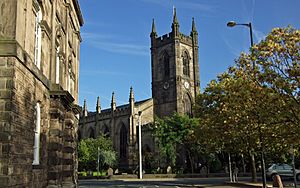Stoke Minster facts for kids
Quick facts for kids Minster Church of St Peter ad Vincula, Stoke-on-Trent |
|
|---|---|
 |
|
| Denomination | Church of England |
| Churchmanship | Broad Church |
| Website | Stoke Minster |
| History | |
| Dedication | St Peter ad Vincula |
| Consecrated | 6 October 1830 |
| Architecture | |
| Heritage designation | Grade II listed |
| Designated | 2 October 1951 |
| Architect(s) | James Trubshaw, Thomas Johnson |
| Style | Commissioners' Gothic Revival |
| Specifications | |
| Bells | 10 (1971) |
| Administration | |
| Parish | Stoke-on-Trent |
| Deanery | Stoke-on-Trent |
| Archdeaconry | Stoke |
| Episcopal area | Stafford |
| Diocese | Lichfield |
| Province | Canterbury |
Stoke Minster is a very important church in Stoke-on-Trent, England. Its full name is the Minster Church of St Peter ad Vincula. It serves as the main church for the whole city of Stoke-on-Trent.
Contents
What's in a Name? The Minster's Meaning
The name "St Peter ad Vincula" means "Saint Peter in Chains." This special name comes from a famous church in Rome called San Pietro in Vincoli. The church was officially renamed Stoke Minster in 2005. This new name shows how important the church is to the community and history of Stoke-on-Trent and North Staffordshire. The word "minster" is an old title given to important churches, often linked to monasteries.
A Look Back: The Minster's Long History
The very first church on this spot was built from wood way back in 670 AD. Later, in 805 AD, a stone church replaced it. This stone building was made bigger many times over the centuries.
Ancient Remains and Special Finds
You can still see parts of the old Anglo-Saxon church in the churchyard today. Some arches there date back to the 13th century. A very old baptismal font (a basin used for baptisms) was found after being used as a garden decoration. It was cleaned up and brought back into the church in 1932.
Famous People Buried Here
Stoke Minster is the resting place for several members of the Josiah Spode family, who were famous potters. Josiah Wedgwood, another very well-known potter, is also buried here. His sons placed a special marble memorial inside the church to remember him.
Becoming a Minster
The title "Stoke Minster" was officially given to the church by Bishop Jonathan Gledhill on May 17, 2005. This was a big moment for the church and the city.
The Church Building: Design and Features
The church you see today was designed by James Trubshaw and Thomas Johnson. Construction started in 1826, and the church was officially opened on October 6, 1830.
Memorials and Bells
Inside the church, you'll find many ceramic memorials. These remember the skilled potters who lived and worked in the area. There's also a modern memorial dedicated to the famous football player Sir Stanley Matthews. The church's west tower has a set of 10 bells. These bells were all remade in 1971 by a company called John Taylor & Co. The tower also has a clock with a single bell, which was made in 1888.
A Protected Building
Stoke Minster has been a Grade II listed building since October 2, 1951. This means it's a historically important building that is protected.
The Church Organ: A Musical History
The church's organ was first built in 1899 by J. J. Binns. It was originally a private organ for a master potter named H. J. Johnson. In 1921, Johnson gave the organ to the church. It was a memorial to his family members who died in World War I. The organ was placed in the west gallery of the church. It was later rebuilt and changed in 1972 by J. W. Walker & Sons Ltd. You can find all the details about this organ at the National Pipe Organ Register.

